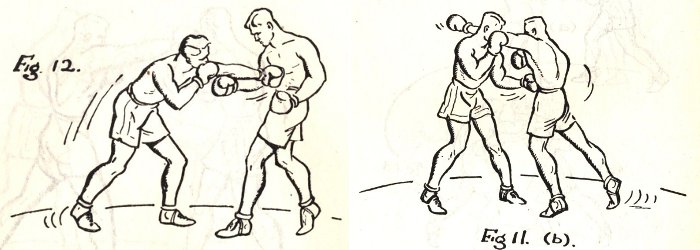Topic: Drill and Training

Boxing
Basic and Battle Physical Training, Part IX; Boxing and Wrestling, 1945
 Chapter 1 — Boxing
Chapter 1 — Boxing
Section 1 — Introduction
1. Instruction in boxing is given to military personnel for two main reasons, first, for its military value and, second, for its recreational value. Boxing also contributes greatly to the development in the soldier of useful physical and moral qualities.
Section 2. — Military Value of Boxing
2. The value of boxing in relation to training for war depends on the method of instruction, and on the spirit in which the training is carried out. Instruction must be based on sound technique, for boxing is an art—the art of being able to defeat brute force by skill. The training should develop the individual soldier's fighting qualities, and should inspire him with a feeling of confidence in his own skill and ability.
3. There is a close similarity between the tactics used in boxing and those used in warfare, and this should be emphasized during training. The "on guard" position, like the attitude of the unit in the fighting zone, should be one of watchful readiness, prepared for either immediate attack or defence. Movement or footwork must be purposeful. The utmost use should be made of the terrain (or ring) to tire out the opponent, and to manoeuvre him into a disadvantageous position. The left and right fists are the advanced guard and the main body respectively, and they fulfill similar purposes—the left to break the opponent's defence, to expose weak spots and to pin him down, the right to exploit any advantages and to deliver the knock-out blow. Similarly in the attack, the skilled boxer, like the skilled commander, does not begin the attack by rushing in to land a favourite punch. He first tries to discover his opponent's weak spots and then at the opportune moment, when the target is vulnerable, he launches his attack with determination, skill, and enterprise.
 4. In boxing there are three types of attack. These are:—
4. In boxing there are three types of attack. These are:—
(a) A direct attack, which is made at speed.
(b) An indirect attack, which is made after inducing the opponent to make a lead or begin an attack. This result can be brought about by showing an opening (i.e., by setting a trap), and then countering as the opponent makes his attack.
(c) A time attack. This takes place when the opponent's attack can be anticipated and a counter blow "in time" made against it (e.g., a right cross counter on an opponent's weak left lead).
5. All the above attacks have the initiative and should force the the defender to conform. The boxer who holds the initiative will dominate the fight. The indirect or time attacks are the most deadly, because they surprise the opponent by hitting him just as he is starting his attack, and at a time when his mind is fully concentrated on attacking. The unexpected blow is always the most devastating one, and has the greatest demoralizing effect. It is the prelude to success both in the boxing ring and on the battlefield.
 6. Just as each arm of the service has its special characteristics, each individual boxer has his strong and weak points, which must be developed in such a way that the strong are strengthened and the weak are concealed. A tall man with a long reach should develop his ability as a long range boxer, and should not "mix it” with a short, stocky opponent, or he may be beaten by employing wrong tactics. A purely defensive boxer will rarely win, although defence, scientifically studied and skillfully applied, may enable a boxer to defeat an unskilled opponent who is bigger and stronger than himself. In addition, a sound defence promotes self-confidence and enables a boxer to maintain the initiative even when he is on the defensive. A successful defensive action should always be followed by a counter-attack.
6. Just as each arm of the service has its special characteristics, each individual boxer has his strong and weak points, which must be developed in such a way that the strong are strengthened and the weak are concealed. A tall man with a long reach should develop his ability as a long range boxer, and should not "mix it” with a short, stocky opponent, or he may be beaten by employing wrong tactics. A purely defensive boxer will rarely win, although defence, scientifically studied and skillfully applied, may enable a boxer to defeat an unskilled opponent who is bigger and stronger than himself. In addition, a sound defence promotes self-confidence and enables a boxer to maintain the initiative even when he is on the defensive. A successful defensive action should always be followed by a counter-attack.
7. As in training the soldier for war, training for boxing must be a real preparation for the actual fight. It must bring the boxer to an optimum state of fitness so that he has the endurance to last the distance, the will to withstand fatigue and pain, and the spirit, skill and ability to conquer his opponent. If he is allowed to train at times when he should be on duty, or to train only under the best conditions of place and weather, he will fight soft. A man will fight as he trains. If he trains hard, and with determination and imagination, he will fight with these same qualities.


